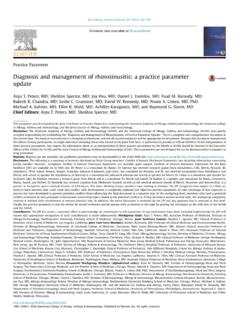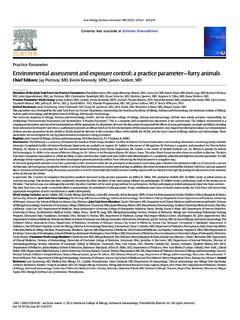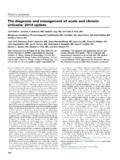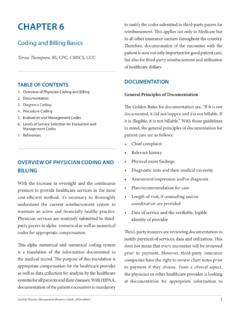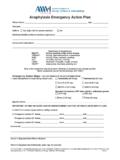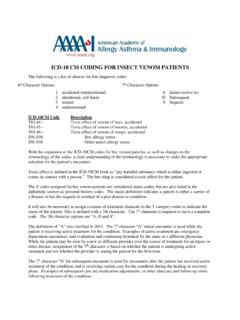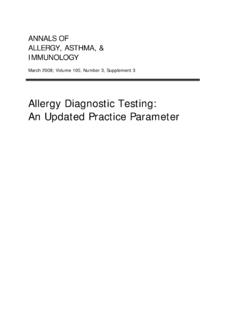Transcription of ANNALS OF ALLERGY, ASTHMA, & IMMUNOLOGY
1 ANNALS OF allergy , ASTHMA, & IMMUNOLOGY March 2008; Volume 100, Number 3, Supplement 3 allergy Diagnostic testing : An Updated practice parameter Practice ParameterAllergy Diagnostic testing : An Updated PracticeParameterI. Leonard Bernstein, MD; James T. Li, MD, PhD; David I. Bernstein, MD;Robert Hamilton, PhD, DABMLI; Sheldon L. Spector, MD; Ricardo Tan, MD; Scott Sicherer, MD;David B. K. Golden, MD; David A. Khan, MD; Richard A. Nicklas, MD; Jay M. Portnoy, MD;Joann Blessing-Moore, MD; Linda Cox, MD; David M. Lang, MD; John Oppenheimer, MD;Christopher C. Randolph, MD; Diane E. Schuller, MD; Stephen A. Tilles, MD; Dana V. Wallace, MD;Estelle Levetin, PhD; and Richard Weber, MDTABLE OF CONTENTSI. S2II.
2 Executive S3 III. Collation of Summary S5IV. Part S15V. In Vivo Diagnostic Tests of Immediate Hypersensitivity S15VI. Organ Challenge S29 VII. Tests to Distinguish Clinical Obstructive Diseases Resembling S33 VIII. In Vivo Diagnostic Tests of Cell-Mediated S34IX. In Vitro Diagnostic Tests of Immediate S43X. In Vitro Diagnostic Tests of Cell-Mediated S59XI. Other Diagnostic Immunologic S64 XII. Unproven S65 XIII. Part S66 XIV. S67XV. Assessment of Inhalant S74 XVI. Assessment of Food Assessment of Stinging Insect Assessment of Drug Assessment of Allergic Contact American Academy of allergy , Asthma and IMMUNOLOGY (AAAAI)and the American College of allergy , Asthma and IMMUNOLOGY (ACAAI) have jointly accepted responsibility for establishing theAllergy Diagnostic testing : An Updated practice parameter .
3 This is acomplete and comprehensive document at the current time. The medicalenvironment is a changing environment and not all recommendationswill be appropriate for all patients. Because this document incorporatedthe efforts of many participants, no single individual, including thosewho served on the Joint Task Force, is authorized to provide an officialAAAAI or ACAAI interpretation of these practice parameters . Anyrequest for information about or an interpretation of these practiceparameters by the AAAAI or ACAAI should be directed to theExecutive Offices of the AAAAI, the ACAAI, and the Joint Council ofAllergy, Asthma and IMMUNOLOGY . These parameters are not designedfor use by pharmaceutical companies in drug for publication October 27, 2007; Accepted for publicationNovember 16, 100, MARCH, 2008S1 PREFACEThe major emphasis of this updated version of PracticeParameters for allergy Diagnostic testing is focused on howtechnological refinements and their validations during thepast decade are being incorporated into the diagnostic arma-mentarium of allergists/clinical immunologists and how theiroptimal use enables confirmation of human clinical sensitiv-ity.
4 The termallergyin this practice parameter denotes majorcategories of human hypersensitivity. Pertinent clinical im-munologic techniques are oriented to this category of adap-tive immunity but not to infection, cancer, or impetus for Practice parameters for allergy Diagnos-tic testing originally stemmed from a consensus conferencesponsored by the National Institute of allergy and InfectiousDiseases and published as a supplement to theJournal ofAllergy and Clinical Immunologyin September 1988. One ofthe major conclusions of that workshop was that periodicreassessment of diagnostic techniques should be mandatory,and in keeping with that recommendation, the 1995 PracticeParameters for allergy Diagnostic Tests further reviewed andconsidered new developments up to that time.
5 In the 13-yearinterval since that publication, there has been an exponentialprogression of basic and translational immunologic research,some of which produced novel and practical diagnostic pos-sibilities. Obviously, these advancements necessitated anoverhaul of the 1995 allergy Diagnostic Parameter commen-surate with the extensive database currently available. Theultimate goals were to formulate recommendations based onevidence-based literature and to achieve balanced use ofclassic and new diagnostic working draft of the Parameter on allergy DiagnosticTests update was based on an outline jointly conceived byJames T. Li and I. Leonard Bernstein and realized by a workgroup (Robert Hamilton, Sheldon Spector, Ricardo Tan,David I.)
6 Bernstein, Scott Sicherer, David B. K. Golden, andDavid Khan) chaired by I. Leonard Bernstein. As with pre-vious parameters , the draft was based on a review of themedical literature using a variety of search engines, such asPubMed. Published clinical and basic studies were rated bycategories of evidence and used to establish the strength ofrecommendations (Table 1). The initial draft was then re-viewed by all members of the Joint Task Force and subse-quently by the American Academy of allergy , Asthma andImmunology (AAAAI), the American College of ALLERGY, Asthma and IMMUNOLOGY (ACAAI), and the Joint Council ofAllergy, Asthma and IMMUNOLOGY and a number of expertson in vivo and in vitro diagnostic IMMUNOLOGY selected by thesupporting organizations.
7 Comments were also solicited fromthe general membership of these societies via their Web document therefore represents an evidence-based,broadly accepted consensus opinion. The peer review processand general format of the practice parameter are consistentwith recommendations of the American College of MedicalQuality, which defines practice guidelines. As such, it isanticipated to serve as a reference source for current utilityand validity of allergy diagnostic organization of Practice parameters on allergy Diag-nostic Tests is similar to previous Joint Task Force parame-ters except that a single algorithm with annotations was notappropriate to the mission of the parameter. The broad rangeof diagnostic techniques for varying purposes could not pos-sibly be stratified into a uniform paradigm encompassingdiverse clinical sensitivity disorders that require objectiveconfirmatory tests.
8 An Executive Summary is followed by acollation of Summary Statements, which also precede refer-enced narrative discussions on each subject. The PracticeParameter is divided into 2 parts: part 1 is a detailed descrip-tion of diagnostic modalities currently available to allergists/clinical immunologists. It encompasses both IgE and cell-mediated in vivo (skin and patch) and in vitro tests for a widespectrum of inhalant, food, and contactant allergens. Organchallenge tests are discussed in greater detail in this revisedPractice Parameter because controlled challenges or super-vised exposure ultimately serve as the appropriate gold stan-dard for assessing whether clinical sensitivity is with their recent emergence as diagnostic ad-juncts, the section concerning current status of cytokines andchemokines has been expanded.
9 A new section on OtherImmunologic Tests has been added in recognition that manyallergists/clinical immunologists have considerable interestsand expertise in a variety of laboratory immunologic tech-niques commonly used to corroborate the diagnosis of non-IgE, non cell-mediated clinical immunologic diseases. Adiscussion about unproven techniques is relevant becausethese methods still have advocates who promote them topatients desperately seeking alternative approaches for theirparticular 2 considers optimal utilization and integration of ev-idence-based diagnostic methods for various clinical situa-tions, which include inhalant, food, insect venom, drug andcontact sensitivities.
10 Practice parameters of diagnosis andmanagement for each of these clinical entities have beenpreviously published with algorithms tailored to fit the spe-cific clinical situation. Many of the diagnostic recommenda-tions of part 2 were extracted or in some cases quotedverbatim from each of these published Joint Task Force acknowledges that rapid advance-ments in diagnostic technology could render specific past andcurrent recommendations obsolete at any time and that at-tempts to revise will have to be undertaken at appropriateintervals. Nevertheless, whatever the update interim periodmay be, the allergy /clinical IMMUNOLOGY community shouldbe prepared to accept novel new diagnostic techniques, pro-vided that they are validated by scientifically accepted overall objectives of this Parameter on allergy Diag-nostic Tests are tripartite: (1) to develop a reliable referenceresource for selecting appropriate diagnostic tests; (2) toprovide guidelines and support for the practicing physician onhow diagnostic tests should be used in an appropriate andS2 ANNALS OF allergy , ASTHMA & IMMUNOLOGY cost-effective manner.
